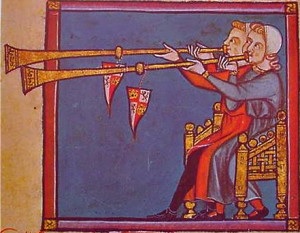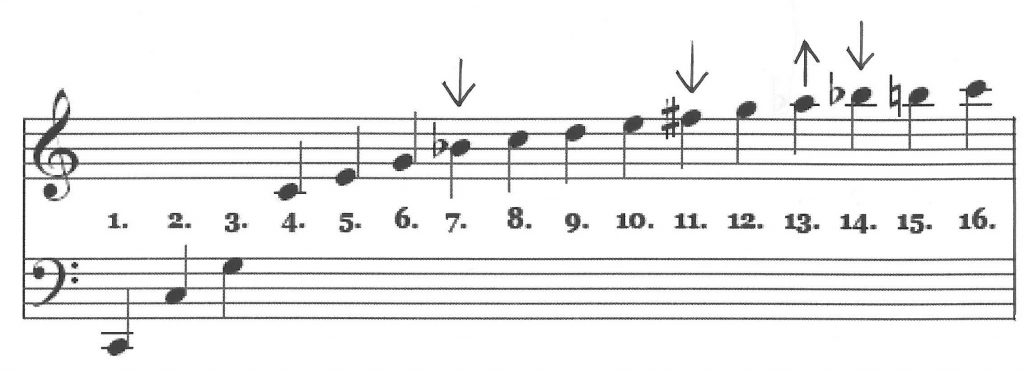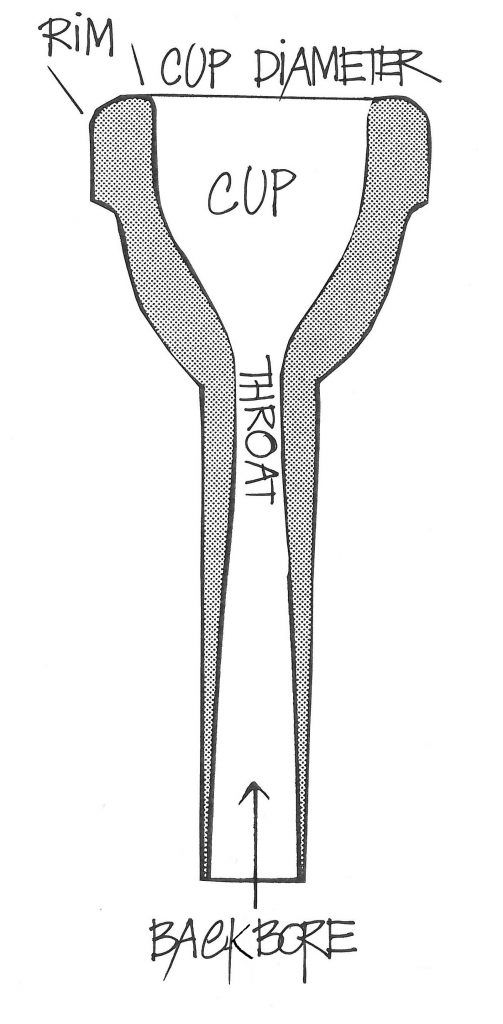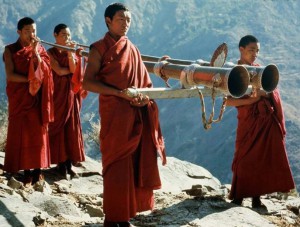I would like to thank all who have contributed to the contents of “The History of Brass instruments”. A special thanks to:
Will Kimball whose site “Trombone History Lifeline” is highly recommended, http://kimballtrombone.com/
Torben Verner Jensen who, with his knowledge and treasure trove of image material has contributed numerous details and illustrations.
Douglas Yeo www.yeodoug.com with many interested articles
Mogens Gaardbo – leading danish expert in military music, www.danskmilitaermusik.dk
Dick Martz www.rjmartz.com/horns huge information about horns
Andrea Van Rij – translation
Dirk Arzig www.brasstacks.de about (mostly germans) instrument makers and instruments
Martin Corfix has given helpful information about danish military music, http://test.regimentsmusik.dk
Richard Carson Steuart for use of photos from www.latrombamusic.com

CONTENTS IN ALL CHAPTERS:
ANCIENT AND MEDIVAL
1 – ACOUSTICS AND TECHNOLOGI / 2 – PREHISTORY, THE ANCIENT AGE (- 500) / 3 – EGYPT / 4 – ISRAEL / 5 – GREECE / 6 – THE ROMAN IMPERIUM / 7 – CENTRAL AND NORTH EUROPE / 8 – ASIA / 9 – MEXICO / 10 – SOUTH AMERICA / 11 – INDIA / 12 – AFRICA / 13 – THE MIDDLE AGES (500 – 1400)
RENAISSANCE
1 – RENAISSANCE (1400 – 1600) / 2 – BOOKS ABOUT MUSICAL INSTRUMENTS / 3 – THE BUILDING OF INSTRUMENTS / 4 – TRUMPET / 5 – THE SLIDE TRUMPET / 6 – THE FOLDED TRUMPET / 7 – THE TRUMPET CORPSES OF THE COURT / 8 – THE ZINK/CORNETT / 9 – SPIRAL INSTRUMENTS / 10 – THE TROMBONE / 11 – CORNETT AND TROMBONE ENSEMBLES / 12-VENICE / 13 – TOWN MUSICIANS AND TOWER MUSIC
BAROQUE
1 – THE BAROQUE (1600-1750) 7 2 – THE TRUMPET / 3 – THE BAROQUE TRUMPET REPERTOIRE and THE TRUMPETERS / 4 – THE CORNETT / 5 – THE HORN 7 6 – CORNO DA CACCIA / 7 – THE POST HORN / 8 – THE TROMBONE / 9 – THE SERPENT / 10 – MUSIC FOR THE ROYAL FIREWORKS / 11 – THE MANNHEIMER COURT ORCHESTRA
VIENNESE
1 – VIENNESE CLASSIC, or THE FIRST VIENNESE SCHOOL (1750 – 1830) / 2 – TRANSPOSING / 3 – THE TRUMPET / 4 – THE KEYED TRUMPET AND ANTON WEIDINGER / 5 – THE HAND STOPPING TRUMPET / 6 – THE SLIDE TRUMPET / 7 – THE FRENCH HORN / 8 – THE HAND HORN TECHNIQUE / 9 – HORN CONCERTOS AND HORN SOLOISTS / 10 – THE HORN SECTION IN THE ORCHESTRA EXTENDS TO FOUR / 11 – CHAMBER MUSIC WITH FRENCH HORN / 12 – PURE HORN ENSEMBLES / 13 – THE HORN USED FOR SIGNALLING / 14 – THE POST HORN / 15 – THE TROMBONE / 16 – CHANGES IN THE CONSTRUCTION OF THE TROMBONE / 17 – TROMBONE ENSEMBLES / 18 – THE TROMBONE AS A FASION INSTRUMENT / 19 – THE KEYED BUGLE / 20 – THE SERPENT / 21 – NEW BRASS INSTRUMENTS / 22 – THE OPHICLEIDE / 23 – WIND ENSEMBLES / 24 – STUDY BOOK FOR ALL BRASS INSTRUMENTS
ROMANTICISM I
1 – ROMANTICISM (1830 – 1900) / 2 – VALVE SYSTEMS AND THEIR INVENTORS / 3 – THE INVENTION OF THE VALVES / 4 – THE NEW VALVE INSTRUMENTS / 5 – ADOLPH SAX (1814 – 1894) / 6 – PIERRE LOUIS GAUTROT (1812 – 1882) / 7 – OTHER INSTRUMENT FAMILIES / 8 – THE CORNET á PISTON / 9 – THE GERMAN/SEDISH CORNET – THE KORNETT
10 – THE FLÜGELHORN / 11 – ALTO HORN, BARITONE and EUPHONIUM / 12 – THE TUBA / 13 – THE HELICON / 14 – AUGUST HELLEBERG (1851 – 1935) / 15 – THE TUBA FAMILY ON POSTCARDS / 16 – VALVE INSTRUMENTS IN THE SYMPHONY ORCHESTRA – LITTLE BY LITTLE ACCEPTED / 17 – THE OSSIAN OUVERTURE / 18 – SYMPHONY ORCHESTRAS GROW LARGER / 19 – RICHARD WAGNER (1818 – 1883) – BIG STRENGTHS / 20 – WAGNER’s STIER HORN / 21 – GUISEPPE VERDI (1813 – 1901) – INSTRUMENTATION, DYNAMICS and BALANCE /n 22 – SMALL ORCHESTRAS / 23 – THE JULIEN ORCHESTRA – ALTERNATELY IN HALF SIZE AND IN VERY LARGE SIZE!
ROMANTICISM II
1 – THE TRUMPET / 2 – SPECIAL TRUMPETS / 3 – THE QUESTIONABLY ETUDES FOR TRUMPET BY JOHANNES BRAHMS / 4 – THE FRENCH HORN IN GERMANY AND BOHEMIA / 5 – THE HORN IN FRANCE / 6 –THE HORN IN AUSTRIA / 7 – THE HORN IN UK / 8 – THE HORN IN USA / 9 – THE WAGNER TUBA / 10 – THE POSTHORN / 11 – THE TROMBONE IN GERMANY / 12 – THE TROMBONE AS A SOLO INSTRUMENT / 13 – THE TROMBONE IN FRANCE / 14 – THE TROMBONE IN UK / 15 – THE VALVE TROMBONE / 16 – THE CIMBASSO / 17 – THE CONTRA BASS TROMBONE / 18 – THE OPHICLEIDE / 23 LOW BRASS IN THE VIENNA OPERA ORCHESTRA
ROMANTICISM III
1 – WIND BANDS/ORCHESTRA / 2 – THE BAND STAND / 3 – THE DISTIN FAMILY / 4 – THE BRASS BAND MOVEMENTS PROPAGATION / 5 – BRASS ORCHESTRA/ENSEMBLES / 6 – WIND BANDS – WILHELM FRIEDRICH WIEPRECHT (1802-1872) / 7 – PATRICK GILMORE (1829-1892) / 8 – TWO FAMOUS STAR CORNET SOLOISTS – JULES LEVY AND MATTHEW ARBUCKLE / 9 – OTHER WIND BANDS / 10 – BACK STAGE BANDA (WIND BAND) IN OPERAS / 11 – BRASS CHAMBER MUSIC COMPOSERS / 12 – BRASS CHAMBER MUSIC ENSEMBLES / 13 – THE BUILDING AF BRASS INSTRUMENTS / 14 – WORLD EXITBITIONS / 15 – GERMAN AND CZECH INSTRUMENT MAKERS / 16 – INSTRUMENT MAKING IN ENGLAND – BESSON / 17 – HENRY DISTIN / 18. VACLAV FRANTISEK CHERVENY / 19 – A WELL TRAINED ORCHESTRA
THE 20’ CENTURY I
1 – THE 20’ CENTURY (1900-) – SYMPHONY ORCHESTRAS / 2 – THE MAKING OF INSTRUMENTS / 3 – NEW INVENTIONS AND NEW TECHNOLOGY / 4 – SHORT-LIVED PROJECTS / 5 – THE TRUMPET / 6 – THE CORNET / 7 – SIGNALING / 8 – THE HORN / 9 – THE POST HORN / 10 – THE TROMBONE / 11 – THE TUBA / 12 – RALPH VAUGHAN WILLIAMS CONCERTO FOR TUBA AND ORCHESTRA / 13 – THE EUPHONIUM IN THE SYMPHONY ORCHESTRA
THE 20’ CENTURY II
1 – CARL NIELSENS INSTRUMENTATION FOR BRASS INSTRUMENTS / 2 – FEMALE BRASS PLAYERS ON POSTCARDS / 3 – FEMALE BRASS PLAYERS IN SYMPHONY ORCHESTRAS / 4 – WIND BANDS / 5 – JOHN PHILIP SOUSA AND HIS FAMOUS SOLOISTS / 6 – BRITISH BRASS BANDS / 7 – MARCHING BAND INSTRUMENTS / 8 – THE GOLDMAN BAND / 9 – POPULAR WIND BANDS AND BRASS BANDS / 10 – CHAMBER MUSIC / BRASS ENSEMBLES/MIXED ENSEMBLES
THE 20’ CENTURY III
1 – JAZZ and RHYTHM / 2 – BRASS INSTRUMENTS IN POPULAR MUSIC /n 3 – WELL KNOWN BRASS PLAYERS IN POPULAR MUSIC / 4 – TECHNIQUE AND TRAINING / 5 – HISTORICAL PERFORMANCE / 6 – “PRIMITIVE” BRASS or LIPWIND INSTRUMENTS / 7 – ASSOCIATIONS AND MAGAZINES FOR BRASS PLAYERS / 8 – THE NATIONAL SOUND AND EXPRESSION / 9 – SOUND AND HARMONY / 10 – POSTSCRIPT

ANCIENT AND MEDIVAL

CONTENTS IN THIS CHAPTER:
Latest updated 5/4 – 2023
1 – ACOUSTICS AND TECHNOLOGI
2 – PREHISTORY, THE ANCIENT AGE (- 500)
3 – EGYPT
4 – ISRAEL
5 – GREECE
6 – THE ROMAN IMPERIUM
7 – CENTRAL AND NORTH EUROPE
8 – ASIA
9 – MEXICO
10 – AFRICA
11 – THE MIDDLE AGES (500 – 1400)

1. ACOUSTICS AND TECHNOLOGY
The main elements of Brass instruments are a funnel shaped MOUTHPIECE, a TUBE and a BELL. When ”buzzing” with your lips, and at the same time blowing into the mouthpiece, the air in the instrument will get into a undulating movement and thus make a tone. In changing the pressure of the lips, the amount of air and the compression, you will be able to make NATURAL TONE SERIES/HARMONIC SERIES. (You could call these instruments ”lip wind instruments”).

HARMONIC SERIES
By looking into the history of Brass instruments you will see how it has come possible to fill the holes in these harmonic series. The sound of a brass instrument depends on the shape of both the mouthpiece and the instrument.
MOUTHPIECE

A bigger Cup diameter gives a bigger sound, a smaller cup diameter will give less sound
A deeper Cup and a bigger BACKBORE will give a darker sound
A flat Cup and a smaller BACKBORE will give a lighter sound
A thin RAND provides great flexibility but can be tiring on the embroidery (the muscles used to “buzz”)
A wide rim seems stable but slightly locked to the embouchure

FOUR MOUTHPIECES with the same cup diameter, but with different inner form
A – Mouthpiece for a baroque trumpet – gives a hard and cracking sound
B – Mouthpiece for a modern trumpet – gives a rounder and fuller soud
C – Mouthpiece for a cornet-à-piston – gives a soft sound
D – Mouthpiece for a french horn – gives a very soft and dark sound
The Tube can be CYLINDRICAL, that means that the tube has the same diameter (bore) from the mouthpiece to the bell.
It gives a compact, brilliant and light sound (trumpet, trombone)
CYLINDRICAL TUBE
– Or the tube can be CONICAL, that means that the diameter of the tube expands from the mouthpiece to the bell. (cornet-à-piston, flugelhorn, french horn, baritone horn, euphonium and tuba)
CONICAL TUBE
Furthermore will the sound of the instrument depend on the different type and thickness of the metal (brass/copper/silver)
2. PREHISTORY, THE ANCIENT AGE (- 500)
BRASS INSTRUMENTS are know since Prehistory, allthough it seems to be more appropriate to call them LIP WIND INSTRUMENTS, as it is the method of playing they have in common, rather than the material they are made of. Most of the prehistoric instruments are made of bronze, wood, animal horn or clay, and not brass. It is unknown what kind of music has been played on instruments of this period, but the loud and intens sound must have been most impressive, and they surely will have been usefull as signalling instruments.
They have probably been in use with religious rituals and big ceremonies, and definitely in military operations.
With those instruments that are made in pairs (i.e. the Lur) would it have been possible to play two tones with a different pitch at the same time, and for us, who are used to the European musical tradition, would it be evident to play melodies with two voices, as the natural harmonics in fact form a natural major third interval, or, it could occasionaly have happend by accident. But when you look at those pairs of prehistory-resembling instruments that are used in countries like India, South America, and Asia, you will see that they play in unison, or they play one after another, and not at the same time.

3. EGYPT

EGYPTIAN TRUMPET
. Two (khnoue) trumpets were found in the tomb of Tutankhamen in Egypt from about 1400 B.C. One of them is made of silver (58 cm. long) and the other of gold plated bronze (49,4 cm. long). Both are provided with a metal ring-shaped mouthpiece. Likewise we know from illustrations that the Assyrian (about 1100-600 B.C. ) had small trumpets.

PAINTED LIMESTONE RELIEF FROM EGYPT ca. 1353-1335 B.C.
Showing a group of dancing girls followed by a man playing the trumpet.
4. ISRAEL

FROM THE TITUS FLAVIUS VESPANIUS’ TRIUMPHAL ARCH IN ROME
The Israelites overtook the Egyptian war trumpet after their excile in Egypt and called it HAZOZRA. The Old Testament (Numbers, Chapter 10 vers 1 – 8) states that the Lord ordered Moses to have two silver hazozra trumpets made, with instructions in what manner, under what circumstances and whether in pairs or singly they should be blown. A scene on the Triumphal Arch of emperor Titus Flavius Vespasianus erected in Rome (A.D. 70) after Jerusalem was conquered, shows two trumpets (hazozras) amongst the war booty.

SHOFAR
Another Israelian lip wind instrument is the SHOFAR, made of a billy goat’s horn, or a ram’s horn (still used in synagogues nowadays). To make a Shofar, the animal horn is heated and shaped by flattening and bending. With the use of 7 of these Shofars Joshua got the walls of Jericho to tumble down.
Illustration showing when the Israeli sofhars get Jerico’s walls to topple:

Here is the Israeli schofars reproduced in oversize – looking like a Danish lur (fig.21):


5. GREECE

SALPINX
The Greek trumpet is called SALPINX. It is shown in many pictures but there is only one example left from about 450 B.C. It is made of ivory parts, held together with rings of bronze. It has a bronze mouthpiece and a bronze bell.
6. THE ROMAN EMPIRE
The Romans got their cast bronze instruments from the Etruscans. The Roman army was a well organized war machine, and we learn from all well-informed sources that the enemies were litteraly ”blown” away by the terrifying sound of the instruments. They used three different instruments, each with its own function.


LITUUS
– was used by the cavalry

Roman TUBA (latin: Tube)
– belonged to the infantery (no connection with the modern tuba)

CORNU
– followed with the flag
The Buccina was similar to the Cornu, and used for the announcement of night watches, and to give orders (a Roman general, who had been surrounded by the enemy, escaped during the night, by leaving a BUCCINATOR behind sounded the watches during the night) . All men who performed on one af the instruments above was called Buccinator).

BUCCINATORS PERFORMING ON TUBA AND CORNU ON TRAJANS COLUMN, ROM AD 113


BUCCINATOR PERFORMING ON CORNU
– RELIEF FROM ROMAN SARCOPHAG, AD250-260


ROMAN SOLDIERS WITH TUBA AND CORNO
– engraving from 1553, Metropolitan Museum New York

BUCCINATORS PERFORMING ON TUBA AND CORNU IN THE CARTOON ASTERIX

7. CENTRAL AND NORTH EUROPE

ALPINE HORN (ALP-HORN)
It is unknown how old the Alpine Horn exactly is. It has the same form as the Roman lituus, but its lenght can vary from 150cm til 340cm. It is made of a piece of wood, split and hollowed out, and thereafter put together again with stripes of bark. The Alpine Horn has been a herdsman- and mountain- instrument, and today it is the national instrument of Switzerland.

A similar instrument is the NEVERLUR from NORWAY and SWEDEN (Birch bark lur)
The birch trumpet (Norwegian neverlur, Swedish: näverlur, Latvian: tās̆u taure, Lithuanien: ragas, daudytė, Finnish: tuohitorvi)
The instrument was used for signaling, usually by shepherds.
Prillarguri is a semi legendary figure who according to oral tradition was a young woman from Norway who played a key role in the Battle of Kringen in August 1612 when Sweden and Denmark-Norway was engaged in the Kalmar war. Because of the signaling playing of Pilarguri a Scottish military force was killed by 500 Norwegian peasants.
COAT OF ARMS
for the municipality of Sel (kommune), Norway featuring Prillarguri

1880 the Swedish farmer Carl Johan Johansson made a strange discovery in a field between Källudden and Stenstugan, he found what is called the Barvalur. He received as much as 25swedish kroner in small wages – a cow cost around 45-60 kroner! The lur is a horn from an ox, coated with bronze fittings and approx. 2000 years old.
THE BARVALUR
Music researcher Cajsa S.Lund with a copy of the Barvaluren
The original can be found at the Historiska museum in Stockholm
Photo: Malin Thelin/Sveriges Radio

– and still another horn made of wood is the MID VINTER HORN from Holland


LUR PLAYERS
– statue at the Town Hall Square in Copenhagen. Some of the most impressive instruments from the Prehistory are the LURS from the bronze age about 1500-400 B.C. They are made of cast pieces that are put into each other, and they are (almost) allways made in pairs, of same size and tuning but with opposite helices. Like the two tusks of a mammoth. All lurs have been found in Denmark (or parts of Germany and Sweden which where Danish at that period), burried in peatbogs and have presumably been used in ceremonies. You can play about 8 natural tones on a lur. Today it is the national instrument of Denmark.

THE CARNYX
– was a wind instrument of the Iron Age Celts, used between c. 200 BC and c. AD 200. It was a type of bronze Trumpet. The bell was styled in the shape of an open-mouthed boar’s, or other animal’s, head. It was used in warfare, probably to incite troops to battle. The instrument’s significant height allowed it, like the Lurs, to be heard over the heads of the participants in battles or ceremonies.
CARNYX HEADS:


THE LOUGHNASHADE TRUMPET, Co. Armagh, IRELAND c. 100 BC
– was discovered during drainage works at the site of a former lake (Loughnashade) in Co. Armagh along with three other horns, since lost. A collection of human skulls and bones was also discovered at the site suggesting some sort of ritual deposition. Measuring 186 cm. in length and made from curved and riveted sheets of bronze, the instrument is one of the finest surviving horns of the European Iron Age.
8. ASIA
DUNG-CHEN (TIBETAN HORN)
– is a 5m long trumpet, from China and Tibet. There are also lip wind instruments in the East from the The Ancient Ages. Similar to the Biblical visions of Judgement Day, where there will be played on ”Judgement Trumpets/Trombones”, the Indian God Shiva will play on a ”Helical Trumpet” when ”the world is in flames”.
8. MEXICO

MEXICAN MAYA INDIANS BLOWING A TRUMPET. Wall painting ca. 400 ac.

10. SOUTH AMERICA

CERAMIC TRUMPET 300 -AD. PERU

PRECOLOMBIAN ANCIENT TRUMPET, EARTHWARE
11. INDIA

KARNA TRUMPET
– is a straight trumpet which came to India with the spread of Islam. It is used in procession ensembles.
12. AFRICA

THE KAKAKI TRUMPET, Africa
– is a metal trumpet three to four meters long used in Hausa traditional ceremonial music. It is only used for royalty and it is only played at events at the palace of the king or emir in Hausa societies.

IVORY SIDE-BLOWN TRUMPETS
These examples above from the Democratic Republic of the Congo show two different types of side-blown trumpets.
The larger trumpet (top), from the Ekonda peoples, was originally intended to be used in battle; today it is used at occasions such as weddings, hunting or planting ceremonies, or the investiture of nkumu (leaders).
The one from the Mangbetu peoples (bottom) is made entirely of ivory, and skilled carvers decorated it in deep relief with an integral, projecting mouthpiece. Elegant trumpets like this are used in pairs or in larger ensembles to accompany dances or signal the king’s entrance and departure.

FIGURE: TRUMPET PLAYER WITH A SIDE-BLOWN INSTRUMENT,
1550–1680. Nigeria,
13. THE MIDDLE AGES (500 – 1400)
With the fall of the Roman Empire the bronze instruments started to disappear into oblivian, although most people had some idea of lipwind- brass instruments through tekst and illustrations from the bible. (in the Latin Bible all lipwindinstruments are called TUBA.)
 We know from the Nordic Mythology that the God Heimdal should blow an alarm on his horn, The Gjallar Horn, as soon as the Ettin ( Old English: Eoten = Giants) were about to attack Walhalla, the home of the gods.
We know from the Nordic Mythology that the God Heimdal should blow an alarm on his horn, The Gjallar Horn, as soon as the Ettin ( Old English: Eoten = Giants) were about to attack Walhalla, the home of the gods.


HEIMDAL WITH THE GJALLARHORN
Drawing of the danish artist Lorenz Frølich (1820-1908). Here the Gjallarhorn is a lur with the bell pointed downward.

HEIMDAL IN BRONZE
The gjallerhorn is here a kind of animal horn.

HEIMDAL WITH LUR
From the danish artist Per Madsens cartoon VALHALLA.

HORN IN THE BAYEUX TAPESTRY from 1066.
The horn playing was used to call William the Conqueror to dinner,

THE SONG OF ROLAND
In the Song of Roland, (Chanson de Roland, Roland, one of the palladin knights of Charlemagne) a French epos from about 1100 A.D. the hero Roland’s horn is called ”Oliphant” a name for drink- and blow horns of ivory. (Old French: Elephant)

OLIPHANT FROM SOUTHERN ITALY 1100
The horn ”Oliphant” gave evidence of the high rank of the owner, and was therefor often artistic carved and plated with precious metals.
“ANGEL PLAYING THE TUBA” from the Cathedral in Saint-Lazare, 13th century
Illustrations in the bible from the early Middle Ages show horns af very different sizes. The biggest horns can not have been animal horns, but they were probably made of copper or wood, taped and hold together with leather.

MIDDLE AGE TUBAS or HORNS


A BELL PLAYER AND AN OLIPHANT PLAYER FROM THE MIDDEL AGE


ARABIEN TRUMPET: “ANAFIL”


TROOP OF HORSEMEN WITH BANNERS, DRUMS AND TRUMPETS
Manuscript from 1237.
The Crusades introduced the European people to the East and the Arabian war music and their trumpets: The short BUG and the long ANAFIL. From this time we see a rising number of reports of the trumpet’s existence:
– In 1191 the English king Richard I is greeted outside the town Acre with the sound of Tubae and Trumpae
– In 1293 the Spanish king of Castile had a ensemble with an anafil, four trompeurs and 5 tamboreros.
– When the Danish king Erik Menved met his brother in law, the Swedish king Birger in Fagradal, Sweden in 1304, the king used pipare, bombare och Trwmbare.

JOHN’S REVELATION
– trumpets given to 7 angels London, between 1255 and 1260.

TOURNAMENT WITH TRUMPET PLAYERS (1300-1330)
Very soon the trumpet became most popular with the knights, who used them as a signal instrument in warfare and tournaments.

MANUSCRIPT WITH TRUMPET PLAYER (1310-1337) FROM YORK, ENGLAND


HARE, PLAYING THE TRUMPET, from the “Danse frieze”
– a fresco in Ørslev Church from about 1350.

2 TRUMPET PLAYERS AND A DRUMMER
– by flamish illuminator Jehan de Grise from THE ROMANCE OF ALEXANDER 1338-1344

DRAWING OF A MEDIEVAL BANQUET WITH DRINKERS, LOVERS AND IMAGINARY ANIMALS PLAYING DRUMS AND TRUMPETS 

U-SHAPED TRUMPET
Marginal decoration from The Hours of Charles the Noble (ca.1404). Cleveland Museum of Art.

TOURNAMENT WITH MUSICIANS
– Engraving from Austria, about 1420, anonymous. 
In the late Middle Ages two different trumpet types came into being: the short Claro or Clarion (means bright, clear) and the almost 2m long Buisine . (the term descends from Buccina, a generel term for the Roman military instruments ).


BUISINES
14th-century manuscript illumination (detail) from Boethius, De Arithmetica. Naples, Biblioteca Nazionale.

FRA ANGELICO (1387-1455): CHRIST GLORIFIED
– with 5 BUISINES and ONE CLARION ?

BUISINE or CLARION ? – with flags.


THE LONG BUISINE
– From Mattio Pagans wood engraving: Procession with the Doge of Venice
As Heimdal in the Nordic Mythology had his horn, the archangel Gabriel (who accompanies the blessed souls into Paradise) had a trumpet, and people started to picture angels with trumpets.










![471031[1]](https://mogensandresen.dk/wp-content/uploads/2014/12/4710311-300x199.jpg)
![Leetrmp2sm[1]](https://mogensandresen.dk/wp-content/uploads/2014/12/Leetrmp2sm1-300x167.jpg)



![26-a-chanson-de-roland[1]](https://mogensandresen.dk/wp-content/uploads/2014/12/26-a-chanson-de-roland1.jpg)
